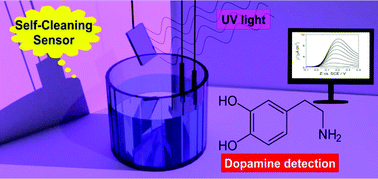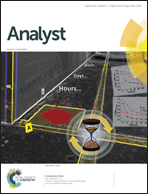Self-cleaning properties in engineered sensors for dopamine electroanalytical detection†
Abstract
Fouling and passivation are the major drawbacks for a wide applicability of electroanalytical sensors based on nanomaterials, especially in biomedical and environmental fields. The production of highly engineered devices, designed ad hoc for specific applications, is the key factor in the direction of overcoming the problem and accessing effective sensors. Here, the fine-tuning of the system, composed of a highly ordered distribution of silver nanoparticles between a bottom silica and a top titania layer, confers multifunctional properties to the device for a biomedical complex challenge: dopamine detection. The crucial importance of each component towards a robust and efficient electroanalytical system is studied. The total recovery of the electrode performance after a simple UV-A cleaning step (self-cleaning), due to the photoactive interface and the aging resistance, is deeply investigated.


 Please wait while we load your content...
Please wait while we load your content...